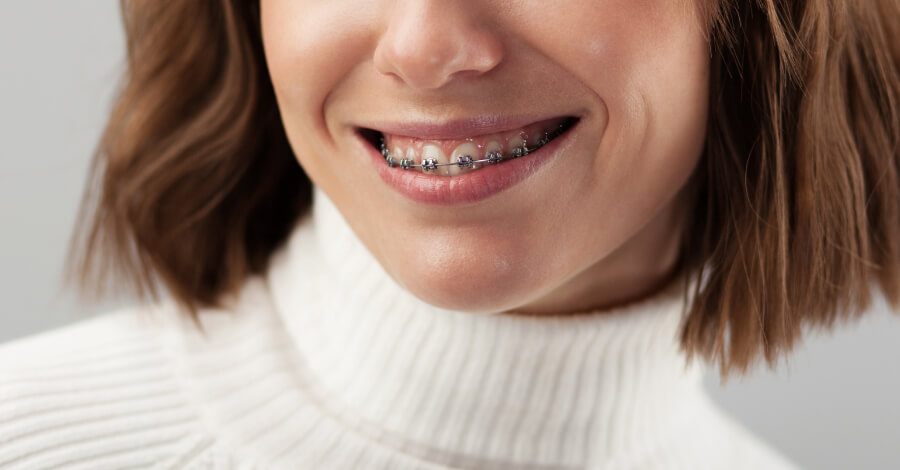Learn What Goes Into Your Orthodontic Treatment with Traditional Braces
Are you considering using traditional braces to achieve a straighter, healthier smile? The Centre for Invisible Orthodontics, led by Dr. Stephen Grussmark, understands that braces remain a popular and effective orthodontic treatment.
This page provides a breakdown of the different parts of braces and the various components that work together to create a beautiful smile through traditional braces. If you have any questions about braces in Miami, FL, contact our top-rated orthodontist today at (305) 441-1200.


What Are Metal Braces?
Braces are dental appliances used to straighten teeth and correct bite problems. They apply gentle, constant pressure to your teeth, gradually shifting them into ideal positions. This process can take months to years, but the result is a healthier, more attractive smile that’s easier to clean and maintain.
Components of Braces
Brackets
Brackets are small squares made of metal or clear ceramic bonded to the front surface of each tooth using a special dental adhesive. Brackets provide the foundation for the rest of the braces system, as they serve as anchor points for the archwire.
Archwire
This thin, metal wire runs along the slots in the brackets, connecting all the teeth. The archwire is the main force behind tooth movement, and its shape and thickness are adjusted throughout treatment to achieve the desired results.
Ligatures
These are small rubber bands or ties that hold the archwire securely in place within the brackets. Ligatures come in various colors, allowing for some degree of customization for a more fun touch. Following the ligatures, elastic bands, also known as orthodontic rubber bands, play a crucial role in connecting the upper and lower jaw to correct the bite and align the upper and lower teeth. Additionally, a power chain, made of rows of connected rubber O-rings, is used to close gaps between teeth more effectively than individual ligatures.
Bands (optional)
In some cases, small metal rings known as molar bands may be cemented onto your molars, the back teeth, for support and stability. These bands provide additional anchorage for the archwire and can be especially helpful in complex orthodontic cases. Elastics worn between hooks on the brackets or bands can also be used for targeted tooth movements and bite correction, focusing on the movement of teeth within the upper arch and improving the alignment of the upper and lower jaw.
Tubes (optional)
Some bracket types have small tubes bonded to them instead of relying on ligatures. These tubes hold the archwire in place, offering a more streamlined appearance. Tiny rubber bands are used as separators between the back teeth to prepare for the placement of these metal bands, ensuring the braces are securely anchored in the mouth.

Why Choose Our Miami Orthodontist for Braces?
As a Miami orthodontist, Dr. Grussmark has years of orthodontic education and experience and has earned the title of Invisalign Diamond Plus Provider. In addition to his distinguished title for Invisalign orthodontics, Dr. Grussmark is also skilled in placing and monitoring the treatment of metal braces.
Our orthodontist in South Florida will design a customized treatment to help you achieve the straighter smile of your dreams. Aligned teeth will dramatically enhance your oral health and self-esteem, so you’ll never feel insecure about flashing your smile again.
Troubleshooting Braces
Living with braces requires some adjustments to your daily routine. Minor discomfort is normal, especially after adjustments or when new elastics are placed. This section will provide tips on how to handle common issues and ensure a smooth orthodontic experience:
- Soreness: Use over-the-counter pain relievers or a cold compress to manage discomfort.
- Loose brackets or wires: Contact Dr. Grussmark as soon as possible to schedule a repair appointment.
- Broken brackets or wires: If a bracket breaks or a wire comes loose, try to save the piece and contact Dr. Grussmark for an immediate appointment. Avoid using the braces to fix them yourself.
- Food restrictions: Certain hard, sticky, or chewy foods can damage braces. We’ll provide a list of foods to avoid and tips for modifying your diet.
- Oral hygiene: Maintaining good oral hygiene is crucial during orthodontic treatment. We’ll provide specific instructions on brushing and flossing with braces.

Frequently Asked Questions
You will typically need to see your orthodontist for adjustments and checkups every four to eight weeks throughout your treatment with traditional braces. This may vary slightly depending on your case and the progress of your treatment.
If a bracket breaks or a wire comes loose, contact your orthodontist as soon as possible to schedule a repair appointment. Avoid using the braces to fix them yourself. If possible, save any broken pieces to bring to your appointment. This will help the orthodontist make the repairs more efficiently.
The best way to determine if traditional braces are the right choice for you is to schedule a consultation with an orthodontist. They can assess your needs and discuss all your orthodontic options, including traditional braces and Invisalign. During the consultation, the orthodontist will examine your teeth and jaw, discuss your smile goals, and answer any questions you may have.
Discover if Braces Are Right for Your Upper and Lower Teeth with Dr. Grussmark
A beautiful smile is within reach! With proper care and adjustments, braces can become a smooth journey towards a straighter, healthier smile. Dr. Stephen Grussmark, a Diamond Plus Invisalign provider, is dedicated to creating personalized treatment plans and ensuring your comfort throughout the process.
Ready to get started? Contact The Centre for Invisible Orthodontics in Miami, FL, at (305) 441-1200 to schedule a consultation. We look forward to helping you achieve the confident smile you deserve! We welcome patients from Brickell, Coral Gables, and Miami Beach.

